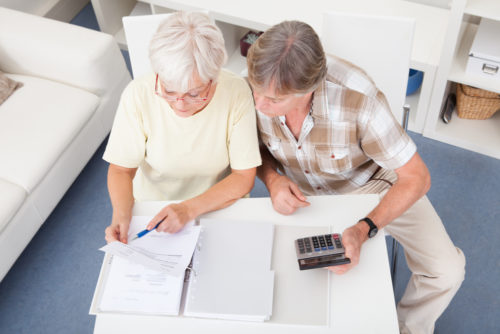If you’ve taken out a reverse mortgage on your home, and you’re worried about being able to get out of it, there are some options for you. A reverse mortgage can be a good way for individuals of retirement age (62+) to gain some additional income or liquidity. However, when you choose to sell your home, or if you’d like to get some of that equity back, you’ll have to pay back whatever was borrowed.
Table of Contents
Can You Reverse a Reverse Mortgage?
Even if you take out some money with your bank or other lender, a reverse mortgage isn’t permanent. However, the money loaned to you will need to be paid back if you decide that you no longer need the reverse mortgage for any reason. If you’re ready to sell your home and move somewhere else, you found another source of income, or perhaps you have family members that are helping you, you aren’t trapped. Whatever the case may be, you’ll need to make a plan for how you’ll be paying back your loan.
What If the Borrower Dies?
Even when the original borrower on a reverse mortgage passes away, there are several opportunities for surviving family to retain ownership of the home.
If your spouse passes away and you’re still living in the house, your lender shouldn’t be able to foreclose on your home or evict you. Even if you didn’t put your name on the paperwork when you decided to open the reverse mortgage, you won’t be held liable. You might not even be a co-borrower on your original mortgage, but as long as you are the legal spouse, in most cases, you should be allowed to continue living in your home.
In another scenario, perhaps you aren’t a resident of the home in question, and a family member or spouse has died and the reverse mortgage becomes due. As a living heir, you have the option of paying off the reverse mortgage and owning the home, if you so choose. If you choose not to take repayment responsibility on the remaining funds, the home will likely become owned by the lender or bank, but if you’d like to keep it in the family, you can choose to pay it off yourself.
How to Get Out of a Reverse Mortgage
Now that we’ve talked about some options you might have as far as selling your home and paying back the reverse mortgage, let’s go over some realistic ways that you can accomplish this task. You shouldn’t feel as if there is only one option for you if you would like to repay your reverse mortgage. There are several routes you can take an each one has their own pros and cons.
Sell Your Home and Repay the Lender
The first option is to simply sell your home and repay the lender. This is a great option if you’ll have some remaining equity leftover after you sell and repay the reverse mortgage. However, of course, you’ll have to find a new home. You should only do this if you’re looking to use your equity to buy a new home, or if you have another residence to occupy.
Using this method, you’ll sell your home and use the proceeds to repay your reverse mortgage. This option is usually good for those who haven’t take out much money in a reverse mortgage, and who have paid off most or all of their original mortgage. As such, if you don’t feel that selling your home is right for you or that the sale will cover the costs of the reverse mortgage, you may want to look into some other options.
Take Out a Conventional Mortgage to Pay Off the Reverse Mortgage
If you have already paid off your home, but you took out a significant reverse mortgage and you’d like to pay that off, you may need to contact your bank about setting up a new mortgage. In most cases, when you take out a reverse mortgage, you can borrow a sum up to the cost of your home. If you have supplemented your income with a loan this large, you may have some trouble paying it back by yourself. This is when a traditional mortgage will help you.
You can use the lump sum from the mortgage to fully pay off your reverse mortgage, but you will then have to be able to handle the monthly payments that come along with that. In addition, traditional mortgages will often have a long term associated with them, which means you may be able to get a long enough term that your monthly payments won’t be too large to handle.
Take Out a Conventional Loan to Pay Off the Reverse Mortgage
When taking out a mortgage sounds like too much for you, then a traditional loan might be a better option. Perhaps you haven’t borrowed enough money to need a new mortgage loan. In this case, a conventional loan might just do the trick. Meet with your lender or bank to discuss what kinds of terms and monthly payments would be available to you.
There are so many different types of loans out there, so it’s important that your lender knows what kind of situation you’re in and what terms will best help you. What’s more, traditional loans or personal loans often have higher interest rates attached to them as opposed to a conventional mortgage. That’s another piece of the puzzle to keep in mind. You could end up paying much more in the long run if you settle on a loan with a giant interest rate.
Refinance Your Reverse Mortgage
Refinancing is usually an option for those who have paid off a good chunk of their mortgage, but they’re having a hard time making their monthly payments. The bank will take the remaining balance and will reorganize the terms of the mortgage.
This same tactic can be applied to reverse mortgages. You simply need to talk to your bank about the option of a new reverse mortgage or negotiating the terms of your current one. If you find a completely new loan with better terms, you can use that loan to pay off your old one. Every lender will have some different options in regards to their leniency and flexibility with reverse mortgages, so make sure you sit down and go through all options with your lender.
Use Savings or Other Assets to Pay Off the Reverse Mortgage
Lastly, if taking out another loan is not an option for you, you might want to look into other savings and assets that you own. If you have other property that is no longer of use to you, that might be a way to pay off your reverse mortgage. This could be another home, vehicles, etc. anything that you no longer need that could be used to pay the debt.
You may also decide that dipping into a savings account or other account is the best possible option instead of opening a new loan. Depending on what your retirement savings looks like, some individuals choose to use some of that savings to pay off their reverse mortgage. Of course, you should only do this if you’re sure that you can continue to live comfortably without those funds.
As you can see, there are several options for individuals looking to pay off their reverse mortgage. Luckily, reverse mortgages are not permanent, binding obligations and you can get out of them if you so choose. It’s important to carefully weigh out your options before you decide on any one method of repaying your reverse mortgage or selling your home. Take a look at how much of an asset your home could be and the equity you may get out of it by selling. From there, you should have a better idea of which of these options will be most beneficial to your financial situation.
Image Source: https://depositphotos.com/





